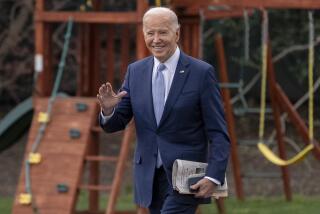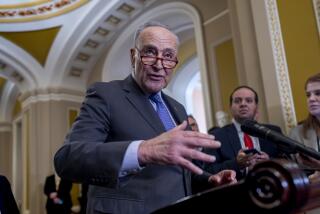Stimulus bill passes House in party-line vote
WASHINGTON — With the House of Representatives and Senate giving final approval to the massive stimulus bill Friday, and President Obama prepared to sign it early next week, the question now is: Just how soon might Americans begin to feel its benefits, and when will they know whether it’s working?
The scale of the legislation is so huge and its provisions so diverse that its effects could potentially be felt in almost every corner of American society -- from small businesses and major industries to individuals in their varied roles as workers, taxpayers and consumers.
Like a time-release capsule, the $787-billion plan will move into the nation’s economic bloodstream in stages. A majority of Americans should see more money in their pockets quickly, as a result of tax cuts designed to reduce withholding and fatten take-home pay. Investments in science, basic research and the so-called green economy may not yield sizable benefits for years, even decades.
The Congressional Budget Office said the legislation would deliver its largest benefits to the nation’s total gross domestic product by the end of this year, with the effect dropping some in 2010 and disappearing altogether by 2013.
The budget office said the bill would have its greatest effect in terms of increasing employment next year, when about 3.6 million jobs could be created. But the report added that the package could have a positive effect on employment for the next five years, perhaps leading to the creation of as many as 11.6 million jobs during that span.
House Republicans contend that the bill will produce only 3.46 million jobs, “500,000 fewer than President Obama promised,” said Michael Steel, a spokesman for House Minority Leader John A. Boehner (R-Ohio).
No Republicans voted for the bill in the House on Friday. The final vote was 246 to 183, with seven Democrats breaking ranks to vote with the GOP. In the Senate, the vote was 60 to 38, with three Republicans -- Sens. Olympia J. Snowe and Susan Collins of Maine and Arlen Specter of Pennsylvania -- voting for the package, just enough to ensure that the GOP could not block the bill with a filibuster.
The margin in the Senate was so tight that Democratic leaders kept the roll call open late Friday until Sen. Sherrod Brown could return to Washington briefly from his home state of Ohio, where memorial services are being held for his mother. Brown cast the 60th vote after arriving on a military jet.
Republicans heaped particular criticism on House Speaker Nancy Pelosi (D-San Francisco). “It’s a one-party bill,” said Rep. Eric Cantor of Virginia, the Republican whip, after the bill passed in the House. “We weren’t allowed to write one word of this bill.”
During debate on the Senate floor, Sen. Richard J. Durbin (D-Ill.) sounded the line many Democrats -- including Obama -- used to answer their critics. “What would they have us do?” he said. “They would have us do nothing.”
The bill provides billions for infrastructure repair, school renovations, aid for cash-strapped states, and aid for the unemployed in the form of healthcare subsidies and extensions of unemployment benefits.
It also features a bevy of tax cuts designed to leave more money in the hands of businesses and individuals.
Here is what people can expect to see in the first wave of effects:
Workers who make less than $75,000 a year (or married couples who make $150,000 or less) will receive $400 tax credits in 2009 and 2010. Those who make more will receive reduced amounts. But instead of mailing out checks, as the Bush administration did with its stimulus plan last year, the government will withhold a little less -- leaving average workers with perhaps $8 extra per week.
Those sums were ridiculed by Republicans and others, who said the bill’s benefits for taxpayers had been wildly inflated.
Still, “that cash has to go somewhere,” said Clint Stretch, managing principal for tax policy in Washington with the consulting firm Deloitte. He said that it was a “pretty direct” form of stimulus and that “nobody has to do anything to get it.”
Those out of work will see unemployment checks immediately increase by $25, up from the average benefit of $200 a week. And eligibility for benefits will last 46 weeks, up from 26 weeks. That money, too, will go to people who are most likely to spend it quickly.
Health insurance subsidies for the unemployed could also have a direct effect, but even with the federal help many may find it hard to afford continued coverage. Workers who lose their jobs must arrange with their employers to continue the coverage and must pay the premiums themselves -- a hefty outlay even with the government now picking up 65% of the cost for nine months for individuals earning up to $125,000 a year ($250,000 for couples).
First-time home buyers can also reap immediate benefits. In lieu of government cash, they can claim an $8,000 tax credit if they buy a home before the end of year.
Similarly, those who buy a new car by the end of the year will be able to deduct the cost of the sales tax.
And many parents of college students will be able to deduct more of the cost of tuition on next year’s tax return (as long as they are paying it, of course).
Small businesses will benefit from a provision in the bill that will allow them to carry back their 2008 losses for five years, leaving them with more capital to spend. Some critics question the effect of this and other business-friendly tax breaks, because in a recession business may not have enough tax liability to take advantage of the deductions.
Deloitte’s Stretch said he was disappointed that final negotiations on the bill resulted in fewer businesses being able to take advantage of the carry-back provision.
Following along after the direct benefits are funds for projects that can create or preserve jobs.
The federal government will deliver $54 billion in aid to cash-strapped states, with some of the money available to prop up state budgets, help maintain services and keep employees on the job.
A large chunk of funds will be available for upgrading school buildings.
Other money could help keep teachers and day-care workers on the payroll. That alone could save or create hundreds of thousands of jobs nationwide, Democrats say.
Counties, cities and municipalities that receive a chunk of stimulus money are expected to green-light so-called shovel-ready projects, using workers and equipment that otherwise might sit idle. The U.S. Conference of Mayors has projected that such projects could yield 1.6 million jobs by the end of next year.
A provision to spend $10 billion on weatherization and other energy-efficiency upgrades for homes and federal buildings is aimed at benefiting the economy in the midterm. Longer-term, the legislation calls for $20 billion to upgrade the nation’s electric grid and $8 billion for high-speed rail projects. There are also large increases in research and development, including $1 billion for NASA and $3 billion for the National Science Foundation.
The National Institutes of Health is a major beneficiary; it will have $10 billion flowing in for biomedical research.
Republicans were critical that the final version of the bill, which was the product of high-velocity negotiations between Democrats and the White House during the week, was not made available to members until Thursday evening.
They said that few had time to review the sprawling 1,000-plus-page document before the Friday votes. Democrats said they had been working on the language since the session began, six weeks ago.
The bill was officially listed at $787 billion Friday, $2 billion less than the estimate from the day before. In spending bills such as this one, the Congressional Budget Office routinely redraws its estimates of the bill’s overall cost based on its analysis of the final language.
--
joliphant@tribune.com
Mark Silva in our Washington bureau contributed to this report.
More to Read
Sign up for Essential California
The most important California stories and recommendations in your inbox every morning.
You may occasionally receive promotional content from the Los Angeles Times.











